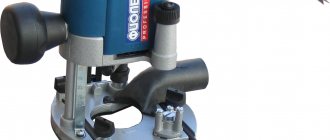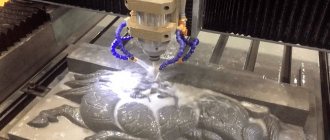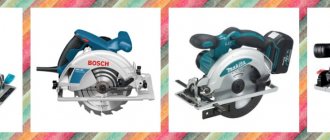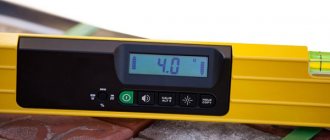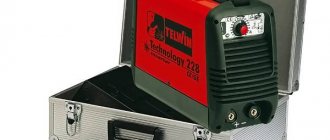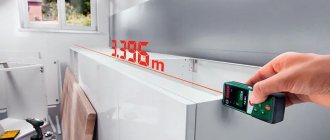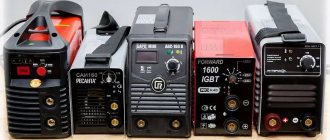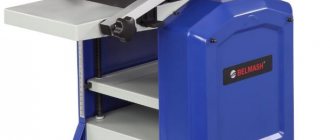Purpose
With its help, various types of carpentry and construction and finishing work are performed. This is a selection of complex and simple profiles of various configurations, a selection of fits for door and frame hinges, door locks and handles. As well as preparing complex and simple connections at the corners of frames, in the middle of furniture pieces. A separate direction is figured wood carving, cutting out arches and circles of different sizes.
Conclusion
As we found out, there are many types of milling equipment that have a different set of functions. However, for home use, in most cases, a conventional hand router is sufficient. If the amount of work is large or complex operations are required, you can purchase a desktop wood milling machine.
You can get additional information on this topic from the video in this article. If the material does not contain all the answers to your questions, you can ask them in the comments, and we will be happy to answer them.
Which manufacturer should you prefer?
A milling cutter is chosen not only by technical characteristics. Two more factors: price and brand reputation. If there are no restrictions on the purchase amount, you should choose well-known brands with a long history. And that's why:
- Such companies have been developing and improving their products for many decades. They have special design bureaus, testing laboratories, and a strong staff of design engineers. As a result, it is these brands that achieve the best performance in all areas: ergonomics (ease of use), efficiency and productivity.
- Famous brands value their reputation. Only manufacturers for whom reputation does not matter can throw a batch of defective milling cutters onto the market under a new name and then disappear. There are many well-known brands, and they constantly compete fiercely with each other, which also stimulates improvement of product quality and, if possible, keeping prices to the minimum.
The two most famous brands in this area are the European (German) Bosch and the Asian (Japanese) Makita. It is quite possible that their production facilities are located in China today. But full control over quality is maintained; equipment, designs, and technologies belong to the brands.
Today, when purchasing such milling cutters, the main thing is to avoid counterfeit goods, which can also be produced in China under the brand label, but in other production facilities.
Main characteristics that you should pay attention to when choosing
In addition to the quality and ergonomics of the entire product, technical parameters are extremely important.
Engine power
The power of the electric motor of milling machines varies over a wide range - from 350 W to 2300 W and is selected based on the work to be done. If you have to process small parts with a shallow profile (fitting under door hinges, processing the edges of boards) or perform figured carvings, a low-power option is better suited, because:
- The weight of the router is lighter, more convenient to work with;
- costs less;
- consumes less energy.
If you have to choose deep grooves (for a door lock, table fastenings) or use a milling cutter with a complex profile with a large diameter, the power of such a router may not be enough. Perhaps it will cope with the task, but with overloads, which is fraught with rapid wear. If the load is too heavy, the engine may simply burn out, or the gearbox parts may break.
The average version with a power of 700 W-1100 W is capable of solving most tasks for a carpentry and furniture workshop. Therefore, such models are the most popular.
The most powerful milling cutters 1700 W-2300 W are purchased for special tasks. They are quite heavy (about 5 kg or more), and it is inconvenient to work with small workpieces. Suitable for cutting deep grooves and wide complex profiles with a large diameter cutter. Their cost is higher than that of low-power ones. Energy consumption is also significant. Therefore, it is not worth buying such a tool unless necessary.
Power type
Battery options are limited in power, and the power in watts (W) is not indicated on such models. Only the voltage of the battery and electric motor in volts is 12 V, 16 V or 18 V. The higher the voltage, the more powerful the router.
Cordless edge router in action
The main advantage of cordless milling machines is their independent power supply. You can work without an electrical wire, which in some cases gets in the way. Independence from the network is relative. Charging the battery still requires mains voltage.
Cordless routers can be considered a special tool. They are used mainly as edge cutters and work with small diameter cutters. They can be indispensable, for example, when covering the ceiling. If the finishing sheet does not fit, the edge can be removed with a router directly under the ceiling. In this case, the wire will not be pulled down. The router itself weighs a little, which is convenient.
They can also be used during finishing when there is no power supply in the building yet. It is convenient for small work, for example, selecting ornaments (wood carving).
But the main tool of this type is network routers (220V). They have no restrictions on engine power for this type of tool. They can be powered up to 1700 W and are capable of performing all the tasks intended for such a tool.
Milling depth
The maximum recess sizes that a router can make are measured in depth and width. Depth is the distance from the top plane of the workpiece to the end of the sample (vertical). Width is the distance from the edge of the workpiece to the end of the sample (horizontally).
The depth and width of the milling depend on the profile of the cutter and how far it extends beyond the support platform. A large diameter cutter makes a wide cut and vice versa. A cutter with a high cutting part makes a deeper cut.
The maximum sample sizes depend on the hardness of the material being processed. Engine power matters here. A lightweight milling cutter may simply not be able to handle a large-diameter cutter that makes deep and wide cuts.
Therefore, manufacturers do not indicate the depth and width of milling in the technical specifications. But the working stroke of the cutter must be indicated. This is the distance by which the collet (cutter clamp) moves relative to the working platform. For example, the working stroke can be 50 mm or 80 mm. This means that the cutter can be maximally extended beyond the support platform into the workpiece by 50 mm or 80 mm.
These data, indicated in the manufacturer's specifications, are not final. You can increase the routing depth by using a cutter with a longer shank or by moving it in the collet. But the cutter must be securely fastened.
As a rule, the more powerful the router and the larger its dimensions, the greater the stroke of the cutter. If you have to process large workpieces, this parameter is important.
Maximum cutter diameter
The larger the diameter of the cutter, the more difficult it is for the router to work. Reason: a thin cutter has a small lever (distance from edge to center). A large diameter cutter is a large lever to counteract the rotational force of the engine.
If you have to work with large-diameter cutters, you should purchase a high-power milling cutter.
Manufacturers do not always indicate the maximum diameter of the cutter in the technical specifications. The space at the collet (clamp) of most routers (except edge routers) is spacious enough to accommodate a large router bit. But this does not mean that a low-power model will work with any cutter without overload. There are no exact technical recommendations on the ratio of power in W/cutter diameter. But in general, for large diameter cutters you need a milling cutter with a power of over 1000W.
Example when the technical data indicates max. cutter diameter – milling cutter Fiolent MF3-1100E F0029.
- power 1100 W;
- Max. cutter diameter – 26 mm.
Collet size
The cutter shanks and collets for clamping them have several standard sizes: 6 mm, 8 mm, 10 mm, 12 mm. Unlike a drill chuck, which can be used to clamp a shank from 1mm to 10mm, a collet is designed to only fit one size.
The router often comes with replaceable collets. For example, 8 mm and 10 mm. These are the most popular sizes. Shanks 6 mm and 12 mm are used less frequently. But if you buy a light or powerful router, most likely, the light router will have 6 mm and 8 mm collets, the powerful one will have 10 mm and 12 mm, and possibly 8 mm.
Therefore, before purchasing a router, you should take a closer look at the diameters of the shanks of the cutters that you plan to use. It is possible that you already have a set of cutters. The main thing is that the necessary cutters fit the new router according to the size of the collet.
Maximum number of revolutions
The higher the speed, the better the surface treatment of the sample. Many milling cutters have a speed control function. But it is practically useless, since after testing work at different speeds, most operators set the maximum speed.
At low speeds, the cutter tears the wood or the engine does not pull, since the reduction in speed occurs due to a decrease in the current supplied to the electric motor.
Different brands compete with each other, trying to overtake competitors in all quality parameters, including turnover. Average values for today are 25,000 rpm - 30,000 rpm. Leading leading brands achieve 33,000 rpm, and you can trust them, since they cannot commit fraud - competitors will check.
An unknown Chinese manufacturer may suddenly claim 35,000 rpm.
But this is most likely just a marketing ploy. We must remember that such ultra-high speeds mean extra loads on the spindle bearing and other components. And the law of physics “what you gain in speed, you lose in strength” applies. That is, the cutter can rotate quickly when idling, but weakly and under load it can lose speed significantly.
Therefore, when choosing, speed is an important criterion , but it is better without “records”. 25,000 rpm - 30,000 rpm is quite enough for high-quality processing . The main thing is that the cutter does not lose much speed during operation, which is also affected by engine power.
Tool weight
The weight of the router can vary from 1.4 kg for light ones to 5 kg and higher for powerful models.
Weight is related to power, but not directly. If the milling cutter is of a high-quality brand, light, expensive alloys of magnesium and aluminum are used in its production. In cheap models, the same parts may be made of heavy ferrous metal.
There is a downside - too light weight with large, awkward dimensions may indicate low reliability of the product. There is a tiny motor in a huge body, gears inside are made of lightweight plastic, etc. This applies to unknown cheap brands.
Weight matters more or less for different jobs. If you have to frequently rearrange the tool, holding it in your hands will make it inconvenient to work with a heavy router.
When the router is simply placed with a platform on a long workpiece and moves along it, weight matters little.
Before buying in a store, it is better to hold the router in your hands and estimate the weight. When purchasing online, the weight must be indicated in the specifications.
Features of the milling machine
The amount of electricity consumed, as well as performance indicators, depend on the power level of the unit. Household units have ratings of up to 1000 W, and professional ones – up to 7000. The length of the product for processing, in turn, depends on the dimensions of the working surface. The distance from it to the spindle determines the diameter of the workpieces that can be used. And the number of spindle revolutions is selected based on the equipment, the specified processing purpose and the level of hardness of the product. Most milling machines have a gearbox with several speed modes, which is more convenient to use.
What a milling machine can be like: SIGN SERVICE catalog
Such an installation can be of vertical or horizontal type, differing in the direction of the spindle axis. You can also purchase a universal model of the device - a combined milling machine. With it, products are processed in several planes at different angles, which is very convenient and practical to use. And widely universal models are distinguished by the presence of an additional head with a moving spindle.
In addition, this equipment can be of different sizes and areas of use. If you need a household unit, a tabletop model with low power is perfect. If this is industrial production, it is better to give preference to installations with higher engine power. They are industrial. Both variations are available on the website of the SINE SERVICE company, both in stock and on order.
Additional functions
Additional features that are not available on all models include:
- work area lighting;
- the presence of a pipe for collecting chips with a vacuum cleaner, a dust removal adapter;
- smooth start;
- speed adjustment.
Basically these are little functional options.
If the workplace is well lit, backlighting is not needed. Do not look into the illumination zone while working.
A dust collector is useful when working in a clean or residential area. It is inconvenient to use in workshops - there is extra noise from the vacuum cleaner, the collection is bulky and interferes with working with the router, the bag quickly becomes clogged.
Soft start gently starts the engine without reducing the voltage in the network. The milling cutter begins to work smoothly, without jerking. A useful feature, but you can do without it.
Speed adjustment is required extremely rarely. Basically, milling cutters operate at maximum speed.
The remaining functions are standard and are available on all milling cutters: a button to prevent accidental activation, height adjustment of the cutter, eyes for a rip fence and a compass.
Ergonomics
Each manufacturer tries to arrange all the components as compactly as possible, and in such a way that it is as convenient to use the tool as possible. This works out differently for everyone. For example, Makita. Milling cutters from this manufacturer are pleasant to hold in your hands.
- centering (weight distribution) is maintained, the tool does not tip to the side, it does not need to be held with force;
- light weight;
- compact dimensions;
- depth adjustment is convenient.
As a result, working with such a tool is pleasant.
Other leading brands also have good user friendliness.
Cheap, low-quality routers can be clunky, bulky, and difficult to use.
It is better to hold the router before purchasing in a real store. By the way it fits in your hands, you can immediately assess the quality based on ergonomics. When purchasing online, you can only evaluate ergonomics by reviews.
Replacement of carbon brushes for different brands is organized differently:
- without disassembling the case, through the plug screws on the case;
- with disassembly of the housing.
The first option is much more convenient. But carbon brushes are rarely replaced. It happens that they last the entire service life of the router itself. Therefore, the replacement method is not very important.
The location of the power cord outlet and its length are important. A short cord will require an extension cord. If the lead is poorly positioned, the wire will interfere with work and there is even a risk of getting into the cutter.
Equipment
The standard package includes:
- the router itself;
- key for fixing the cutter in the collet. (Two keys, if the spindle is fixed not by a stopper in the body, but also by a key);
- parallel stop;
- replaceable collet for the shank of cutters of other sizes;
- user manual.
In addition to the listed accessories, the extended (full) package includes:
- compass (bar with a centering cone (needle) for processing circles);
- copy sleeve (for moving the router along curved templates);
- copy roller for working together with a parallel stop;
- adapter for connecting a vacuum cleaner;
- simple groove cutter.
Additional accessories are simple devices, inexpensive and do not increase the overall price of the kit by much. It happens that some devices are simply not needed. They lie on the shelf for years or are even thrown away. The opposite also happens when you have to buy some devices separately or make them yourself. For example, making a compass with your own hands is not difficult.
As a result: everything necessary for full-fledged work is included in any configuration. Full may be a nice bonus, but not fundamentally important. When choosing a router, it is the one that is evaluated first. Options are a secondary matter.
Classification of cutters
Milling cutters vary in shape, size and type. Their lower part looks like a cylinder, which is attached to the spindle. The upper part has different shapes, depending on the milling method.
All nozzles are divided into two large groups:
- With solid base. Their main function is to groove the board.
- With guide bearing. Thanks to the bearing, the cutter does not cut into the wood more than necessary.
Milling cutter models
Solid base cutters include:
- Rectangular. Ensures precise cutting of large grooves at right angles.
- "V"-shaped. Make triangular grooves.
- Galtelnye nozzles. Allows you to produce rounded grooves.
- "Dovetail". Grinding of boards with internal expansion is carried out. This happens during the manufacture of furniture and the installation of closed type locks.
Solid base cutters
Among the cutters with guide bearings there are:
Types of cutters with guide bearings
- Conical. Cut the edge at an angle. Most often at 45˚.
- Profile. Their shape allows you to make decorative elements. It is a circle with protrusions.
- Moulded. Round the edge of the wooden piece until it is perfectly smooth.
- Folded. The main function (like a disk cutter) is milling a quarter of a block.
- Galtelnye. With their help you can make a decorative pattern on wood.
- Disk. They make grooves in the workpieces.
A hand-held milling device is a compact tool that allows you to independently perform a lot of work with wood and some other materials. There are many models with different characteristics, from which you can choose what you need.
Related video: Choosing a hand router for beginners
Publications on the topic
Step-by-step instructions for making a stationary circular saw with your own hands
Options for making a router from a grinder with your own hands
Creating a milling and copying machine at home
What to choose for your home workshop
Using a router in a home workshop involves long hours of work. Therefore, you need a high-quality model from brands with a good reputation.
Power is selected based on needs. The middle option is Makita RP0900K 900W . One of the most inexpensive models of the brand with such power due to the lack of additional functions - no speed control, no soft start. The homeland of the brand is Japan, the country of origin is China. Cost 8-10 thousand rubles.
A more serious option is Makita 3612 C 1850W . The price at the end of 2022 is 22-23 thousand rubles. The homeland of the brand is Japan, the country of origin is China. If you wish, you can find milling cutters of this brand made not in China, but in Japan. They cost a little more, but this is purely Japanese quality.
After watching the video, you can read the full review of the Makita 3612 C manual electric wood router and see the delivery set.
The representative of the German brand is Bosch GOF 130 06016B7000 1300W . price from 8 to 9 thousand rubles. Produced in China.
Types of hand routers
When deciding which router is best to choose, you should keep in mind that all such devices may fall into one of the following categories:
- top type milling cutters;
- manual edge milling cutters;
- lamellar milling power tools.
Processing overhangs with an edge router
The top type manual electric router can be stationary or submersible. The design of a stationary type milling cutter includes an electric motor connected through elements of the kinematic circuit of the device to a chuck in which the tool being used is fixed. Such a milling cutter is called stationary for the reason that the tool in it does not have the ability to move relative to the body of the device. Using such a router is quite difficult, since the depth of processing performed when using it has to be adjusted manually, manipulating the entire device, which can be quite heavy.
Much more convenient to use is a plunge router, the drive motor of which is mounted on special guides and can move along them along with the working attachment during processing. The design of plunge-type milling machines also has a special spring, which ensures the lifting of the working nozzle after processing with its help is completed. If, in the process of purchasing top-type milling cutters, you choose which one is better, then you should definitely pay attention to submersible models, which are perfect for both professionals and beginners.
Plunge router controls
The edge milling machine, in full accordance with its name, is used for processing the edges of products and chamfering them. By equipping an edge router with working attachments of various types, you can process not only straight, but also shaped surfaces. In particular, using such a router and the corresponding cutting tool, you can make skirting boards and process shaped door panels.
A lamellar milling cutter, which is used primarily to create various grooves on the surface of the workpiece, is a highly specialized power tool.
Forming grooves for keys with a lamellar router
Thus, today the consumer is offered various types of milling cutters, the design of each of which is designed to solve specific technological problems. Knowing the answer to the question of why you need a router, you can always choose exactly the model that will fully meet your needs.
When choosing a router, you should not forget that its functionality and ease of working with it will also depend on the additional accessories that you will use with the power tool. Such devices, which, in particular, include various stops, clamps, templates, guides, etc., allow processing to be performed with higher accuracy and safety.
Choosing a tool with prospects for use as a milling machine
Manual models are sometimes used in stationary mode. Place the routers on the table in an inverted position, with the cutter facing up above the work table.
In stationary mode, the router remains switched on longer than in manual mode. Therefore, “motor resource” is important, the ability to work for a long time without rapid wear. The electric motor should not overheat. Large sample sizes contribute to overheating of a weak engine. Therefore, the router must be powerful enough to handle heavy loads without overheating.
The Makita 3612 C described above is suitable for these purposes . If there are no restrictions on the purchase price, you can use the professional model BOSCH GOF 1250 LCE Professional + L with an average power of 1250 W, costing more than 40 thousand rubles.
For small, rare jobs, it is better to use a budget milling cutter of medium power.
You cannot expect that a manual milling cutter with a brushed commutator motor will operate in a stationary mode in the same way as machines with asynchronous motors. But for a small sample, when manufacturing expensive products, this option is quite suitable.
Precisely selected power tools are the key to successful work. The modern market offers the widest selection of milling cutters. Knowing the criteria by which to choose, you can slowly select the right option.
General information
Purpose
A wood milling machine was originally intended for profile and flat planing, for example, for processing edges, edges of workpieces, etc. However, the functionality of modern equipment is not limited to these tasks.
In particular, the machines allow you to perform the following operations:
- cut blanks or parts from solid wood;
- make a cut;
- select grooves and make holes;
- apply complex ornaments and three-dimensional designs.
As a result of this versatility, routing is perhaps the most common type of woodworking.
Volumetric milling
Design and principle of operation
Typically, a milling machine consists of the following main elements:
- beds;
- calipers;
- desktop;
- insert spindle;
- spindle shaft;
- cutters (cutting tools).
Main elements of the machine
The design of the machine may be different, however, in any case, the processing principle is that the cutting cutter rotates at high speed, cutting off excess wood. In this case, either the workpiece or the support itself performs reciprocating movements.
